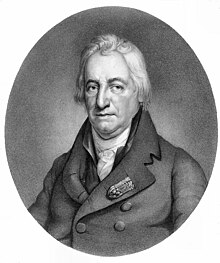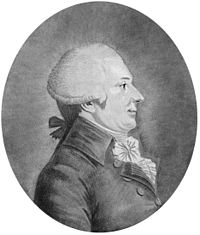Claude Louis Berthollet | |
|---|---|
 | |
| Born | 9 December 1748 |
| Died | 6 November 1822 (aged 73) |
| Nationality | Savoyard-French |
| Alma mater | Chambéry, Turin |
| Scientific career | |
| Fields | Chemistry |
| Institutions | Academy of Science |
https://en.wikipedia.org/wiki/Claude_Louis_Berthollet
Antoine François Fourcroy (15 June 1755 – 16 December 1809) was a French chemist and a contemporary of Antoine Lavoisier. Fourcroy collaborated with Lavoisier, Guyton de Morveau, and Claude Berthollet on the Méthode de nomenclature chimique, a work that helped standardize chemical nomenclature.
Antoine-François de Fourcroy | |
|---|---|
 Fourcroy with the first volume of his book Systeme des connaissances chimiques, painted by François Dumont c. 1800 | |
| Born | 15 June 1755 |
| Died | 16 December 1809 (aged 54) |
| Resting place | Père Lachaise Cemetery |
| Nationality | French |
| Citizenship | French |
| Known for | Co-discovered Iridium Co-founded Modern Chemical Nomenclature |
| Scientific career | |
| Fields | Chemistry Neurochemistry |
| Doctoral advisor | Jean Baptiste Michel Bucquet |
| Doctoral students | Louis Nicolas Vauquelin |
https://en.wikipedia.org/wiki/Antoine-François_de_Fourcroy
Awards and honors[edit]
During his lifetime, Guyton de Morveau received the cross of the Legion of Honour (1803) and was made an Officer of the Legion of Honour for service to humanity (1805). He was made a baron of the First French Empire in 1811.[12][13]Louis Bernard Guyton de Morveau‘s 1788 publication entitled Méthode de Nomenclature Chimique, published with colleagues Antoine Lavoisier, Claude Louis Berthollet, and Antoine François, comte de Fourcroy,[14] was honored by a Citation for Chemical Breakthrough Award from the Division of History of Chemistry of the American Chemical Society, presented at the Académie des Sciences (Paris) in 2015.[15][16]
Guyton de Morveau died in Paris on 2 January 1816.[12]
Louis-Bernard Guyton de Morveau | |
|---|---|
 Louis-Bernard Guyton de Morveau | |
| Born | 4 January 1737 |
| Died | 2 January 1816 (aged 78) |
| Nationality | French |
| Known for | chemical nomenclature |
| Spouse(s) | Claudine Picardet |
| Scientific career | |
| Fields | chemistry |
https://en.wikipedia.org/wiki/Louis-Bernard_Guyton_de_Morveau
Antoine-Laurent de Lavoisier (French: [ɑ̃twan lɔʁɑ̃ də lavwazje] UK: /læˈvwʌzieɪ/ lav-WUZ-ee-ay,[1] US: /ləˈvwɑːzieɪ/ lə-VWAH-zee-ay,[2][3]; 26 August 1743 – 8 May 1794),[4] also Antoine Lavoisier after the French Revolution, was a French nobleman and chemist who was central to the 18th-century chemical revolution and who had a large influence on both the history of chemistry and the history of biology.[5]
Antoine-Laurent de Lavoisier | |
|---|---|
 | |
| Born | 26 August 1743 |
| Died | 8 May 1794 (aged 50) Paris, France |
| Cause of death | Execution by guillotine |
| Resting place | Catacombs of Paris |
| Alma mater | Collège des Quatre-Nations, University of Paris |
| Known for | |
| Spouse(s) | Marie-Anne Paulze Lavoisier(married 1771–1794) |
| Scientific career | |
| Fields | Biologist, chemist |
| Notable students | Éleuthère Irénée du Pont |
| Influences | Guillaume-François Rouelle, Étienne Condillac |
| Signature | |
 | |
https://en.wikipedia.org/wiki/Antoine_Lavoisier
No comments:
Post a Comment